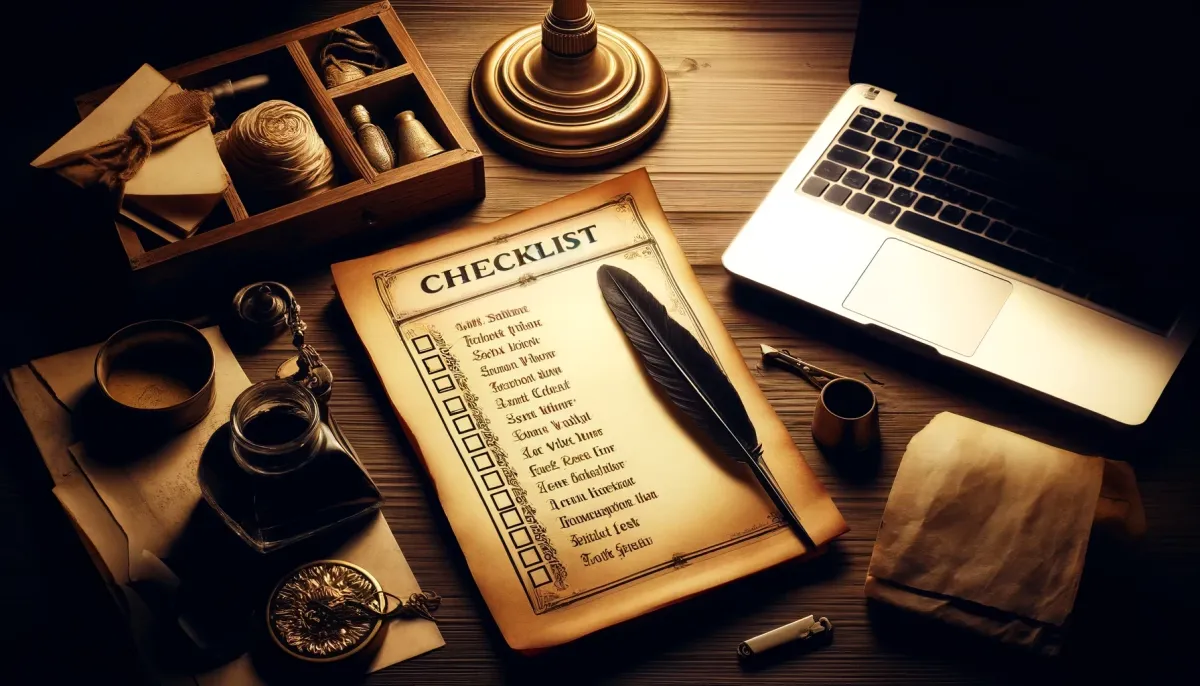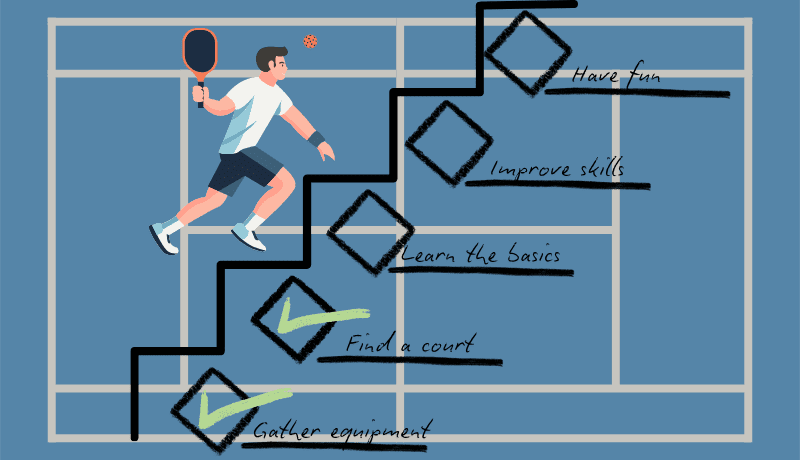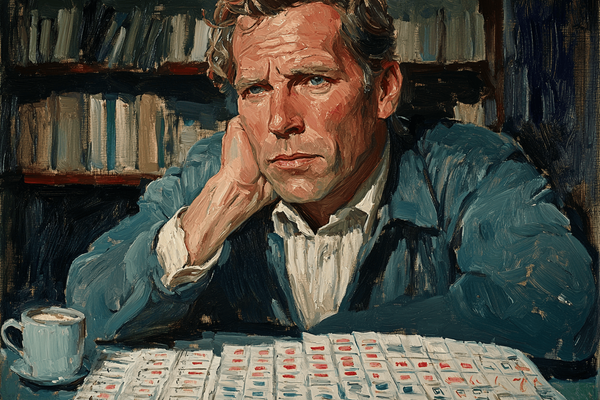How to Make a Checklist That Works?
Not every checklist is useful, even if you use a free checklist template. This article describes the steps for creating a good checklist.

Life Is Complex
When you seek predictable results and must put in significant effort to achieve them, your memory may begin to falter.
For instance, consider packing for a week-long trip. While this task seems simple, it involves several stages. For many, it is infrequent, so even the necessary memories may be lacking. Generally, you need to gather documents and money and pack some clothes.
Everything may appear to be in order, but upon arriving home, you might discover that perishable food has been left in the refrigerator the entire time, and disposing of it becomes an unpleasant chore.
Life is intricate and filled with nuances. These nuances resemble fractals: the more you examine them, the more details you uncover. The ability to acknowledge and manage these nuances is what typically defines the quality of life.
There are various tools available to navigate life's complexities: sophisticated devices, smart homes, and automation systems. However, these solutions come later; initially, there must be an understanding of what needs to be done to address this complexity. This understanding often takes the form of a checklist.
Effective checklists are crucial for managing tasks efficiently, particularly when tackling complex projects in life or at work.
Free Checklist Templates Have Drawbacks
People often search for terms like “free checklist templates” or “event planning checklists”. However, I believe that free templates, or even paid ones, may not fully address your specific needs. While they can serve as sources of inspiration and even be incredibly helpful here, it’s important not to rely on them blindly. Take a moment to reconsider the structure and task descriptions.
Ultimately, the key lies in updating and creating custom checklists for more efficient task completion. This blog post focuses on that very topic. Checklists can also help automate repetitive tasks, making them less time-consuming and more manageable. These checklists ensure that tasks are organized, leading to improved efficiency and productivity.
How to Create a Checklist
Not all checklists are equally effective. In this section, we'll explore how to create a checklist that is both convenient and user-friendly. When developing checklists, you can also create checklist templates that can be reused for similar tasks in the future. We won't delve too deeply into that now; instead, let's focus on creating a simple, reusable, and practical checklist.
We’ll use the example of packing for a week-long trip, as mentioned earlier. To keep things concise, we won't cover every detail. While we could start with a checklist template, let's come up with all the tasks based on personal experience.
So, the List of Steps to Create an Effective Checklist
- Start with Purpose,
- Refine the Purpose,
- Identify Important Tasks,
- Declutter Tasks,
- Break Down Items,
- Polish the Checklist,
- Determine Placement.
Starting Checklist Creation with a Purpose

Let's begin by discussing the purpose of the checklist. Why do you need to prepare for a trip at all? You could simply wake up and go, but while that is possible, it is unlikely to lead to a satisfying experience due to the numerous problems that may arise along the way.
When asked, “Why prepare for a trip?” the initial response often sounds vague, unless you are trained in goal setting. A common reply might be, “So that the trip will be okay.” While this is imprecise, it serves as a starting point.
Refining the Vague Purpose

To refine our understanding, we can apply thinking tools from the Japanese industry. In lean manufacturing, there is a technique called “5 why’s”, which involves repeatedly asking “why” to uncover deeper causes of phenomena. However, instead of asking “why?” we will ask “what is?” — and we’ll do this just once to maintain focus.
What does “So that the trip will be okay” actually mean? Here’s a more detailed description:
- The trip is comfortable.
- Upon returning, you won’t have to deal with household problems caused by your absence.
Now we have a clearer purpose. While we haven't uncovered a universal law for a good trip, we do have two main categories to guide us.
Your Context Might Be Vast
If you are employed or run a business, consider adding a goal related to delegating work while you are away. Additionally, if you have pets, ensuring their well-being could also be a concern. For brevity, we will focus on the two previously mentioned aspects. Next, we need to determine how to achieve these goals.
Thinking of Important Tasks to Fulfill the Checklist's Purpose

How can I achieve comfort while traveling? I need clothes, toiletries, and electronics. These are excellent items to include as the first entries on my checklist.
How can I avoid problems upon returning home? It is essential to dispose of perishable food, close the windows, and turn off electrical appliances. These tasks are critical for the safety of your home. It is better to manage the burden of tracked and completed tasks than to face a complete disaster upon returning after a few weeks.
So, here is the first version of the checklist:
☐ Take clothes, toiletries, and electronics.
☐ Throw away perishable food, close windows, turn off electrical appliances.Using checkboxes instead of bullet points can enhance task tracking. This universal layout allows you to monitor progress more effectively. We will definitely use a check box in front of every separate task. If we used some checklist software, we even could simply click it and go.
Decluttering Tasks for an Effective Checklist

Did we find a good tool? No, it's still quite basic, and each item description is clumsy. This checklist needs refinement.
Imagine yourself rushing the day before departure. You need clear instructions so that completing the checklist is a straightforward sequence of steps, rather than a chaotic process. First, it's essential to separate logically unrelated items so that one unfinished task does not hinder another.
☐ Take clothes.
☐ Take toiletries.
☐ Take electronics.
☐ Throw away perishable food.
☐ Close windows.
☐ Turn off electrical appliances.Now that our points have become independent, we have a group of list items. We don't prioritize tasks in this simple checklist because everything is necessary. There is no hierarchy here; you can follow the natural order and decide what works best for you while gathering. However, task prioritization is sometimes crucial for ensuring that the most important tasks are completed first.
Breaking Down Checklist Items into Simpler Steps

If you live in an ordinary apartment with one refrigerator, the last three points seem quite sufficient. After all, there is a high chance you won’t get confused while completing any of them.
However, the first three points are still too vague; they do not allow you to clear your mind and follow the instructions effectively. We need more tasks and better task segmentation. Again, let's ask the question, “What is?”
What is “take clothes”?
The simplified answer is as follows:
☐ Take T-shirts by the number of nights.
☐ Take the underwear by the number of nights.
☐ Take spare trousers.
☐ Take a warm sweater.What is “take toiletries”?
☐ Take a toothbrush.
☐ Take dental floss.
☐ Take a toothpaste.
☐ Take shampoo.
☐ Take a shower gel.
☐ Take deodorant.What is “take electronics”?
☐ Take a laptop with charger.
☐ Take a charger for the phone.
☐ Take the headphones' charger.The One-Week Trip Checklist Combined
Let's look at our list of preparations for the trip in its entirety:
☐ Take T-shirts by the number of nights.
☐ Take the underwear by the number of nights.
☐ Take spare trousers.
☐ Take a warm sweater.
☐ Take a toothbrush.
☐ Take dental floss.
☐ Take a toothpaste.
☐ Take shampoo.
☐ Take a shower gel.
☐ Take deodorant.
☐ Take a laptop with charger.
☐ Take a charger for the phone.
☐ Take the headphones' charger.
☐ Throw away perishable food.
☐ Close windows.
☐ Turn off electrical appliances.Polishing the Checklist

It's almost ready. Let's remove excess phrases and punctuation. The checklist will be used in a specific context and will provide the necessary hints. In some ways, a checklist is not a purely literary text; we can sacrifice certain spelling rules to reduce noise and enhance the effectiveness of the tool.
Here’s the checklist for preparing for the trip:
☐ T-shirts by number of nights
☐ Underwear by number of nights
☐ Spare trousers
☐ Warm sweater
☐ Toothbrush
☐ Dental floss
☐ Toothpaste
☐ Shampoo
☐ Shower gel
☐ Deodorant
☐ Laptop with charger
☐ Phone charger
☐ Headphones charger
☐ Throw away perishable food
☐ Close windows
☐ Turn off electrical appliancesThere are two types of checklist items: specific items like “something” (e.g., Shampoo) and specific tasks like “do something” (e.g., Close windows). Stylistic consistency is not essential, we are primarily interested in the outcomes that arise from using this list.
As checklist users, we value the results provided by the completed items. To enhance this experience, consider how you format the checklist. For example, bolding important tasks, changing cell colors, and adjusting indents can significantly improve readability and task management. It can also mark important information or highlight the priority.
After You Create a Checklist, Where Should You Place It?

Now that the checklist seems ready, each point offers clear benefits and can be completed in just a few actions, ensuring task accessibility. However, we still need to determine where to store it. We have already discussed the context; let’s move on to practical placement.
A checklist serves both as a tool and as documentation. Documentation often presents challenges, one of which is detachment. Will you remember the checklist when preparing for your next trip? It’s highly unlikely. So, what can you do?
Print the checklist and place it in an empty suitcase, ensuring it is readily available at the right time. This approach will also save you time. If you have multiple bags, consider placing copies of your printed checklist in all of them for added convenience.
What Could Be the Place for Other Checklists?
You can also save a file in your project folder on your computer so that it is always visible. If there isn’t enough space in your organizing box, customize it by writing your checklist on its side or attaching it inside. This way, you won't forget it, and you can edit it as needed.
If you're reading a book and want to do more but often forget, add a note to your bookmark so it’s always in front of your eyes.
Think about the placement of your future checklists as well. The key is to position your checklist in the most intuitive location for the goal you want to achieve. The place where you will apply this checklist regularly.
Conclusion
I have a checklist in my collection dedicated to trip planning. I regularly use this checklist by adding it to my to-do list application when necessary. To-do lists can be seen as a type of checklist, as they contain tasks to be completed. There is also a done list for tasks completed before.
However, checklists are stable, while to-do lists are not.
Checklists serve personal needs by providing productivity-related positive reinforcement and a sense of satisfaction upon completion. They are also actively used in business processes and project management.
For example, at my job, when tasks move through the workflow, we automatically add stage-related checklists to improve task efficiency.
Method Recap
It's easy to forget the method for creating a checklist, so here’s a brief recap:
- Determine the approximate purpose of the checklist.
- Use the question “what is?” to clarify the purpose as many times as necessary. The defined purpose may consist of several parts.
- Answer the question “how to achieve?” for each part of the purpose.
- Divide logically independent parts of the answer into separate points.
- If some points are vague, clarify them with the question “what is?” This should be applied to the items until they become specific. A specific item is one that is understandable to its executor.
- Remove unnecessary literary components and punctuation from the checklist.
- Place the checklist as close as possible to where it will be used.
Is this knowledge enough to create checklists? Yes, it is! Is there anything else to know about checklist creation? Absolutely. For instance, a checklist can evolve as its purpose becomes clearer or its context changes. But that’s a topic for another article.
Thank you for reading! I hope you now feel confident in creating your own checklists. Let your checklists do the decent work for you!
Pleased to learn how to create a good checklist? Subscribe to the “So List” blog and discover more about the forms lists and checklists take. You'll be amazed at their variety! You'll also receive a prompt to streamline the checklists' creation.
List of links
[1] “Five whys” from Wikipedia



